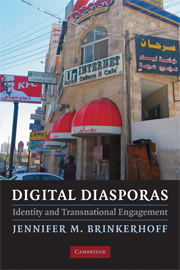Book contents
- Frontmatter
- Contents
- Tables and Figure
- Acknowledgments
- Digital Diasporas
- 1 Introduction
- 2 Diasporas, Identity, and Information Technology
- 3 Keeping the Dream Alive
- 4 Digital Diasporas as Cybercommunities
- 5 Digital Diasporas and Conflict Prevention
- 6 Policy Agendas, Human Rights, and National Sovereignty
- 7 Helping the Homeland
- 8 Digital Diasporas: A New Avenue for Peace and Prosperity?
- Appendix
- Acronyms
- Bibliography
- Index
Appendix
Published online by Cambridge University Press: 05 June 2012
- Frontmatter
- Contents
- Tables and Figure
- Acknowledgments
- Digital Diasporas
- 1 Introduction
- 2 Diasporas, Identity, and Information Technology
- 3 Keeping the Dream Alive
- 4 Digital Diasporas as Cybercommunities
- 5 Digital Diasporas and Conflict Prevention
- 6 Policy Agendas, Human Rights, and National Sovereignty
- 7 Helping the Homeland
- 8 Digital Diasporas: A New Avenue for Peace and Prosperity?
- Appendix
- Acronyms
- Bibliography
- Index
Summary
For the CGOs, web pages and their interactive components were analyzed along two dimensions: the nature of the benefit gained from the member's participation and the type of communication involved. The analysis builds on Wilson's (1995) three types of member benefits: purposive, material, and solidary, discussed in Chapter 2. Members generate purposive benefits when they pursue goals directed beyond the boundaries of the organization. These might include the provision of services to nonmembers or advocating for a particular cause. Material benefits include information, referrals, and the tangible outcomes of service delivery. Solidarity (associational advantages that flow from feeling connected to others and belonging to a community) cannot be created without a core membership, so a quantitative analysis (frequency of posts, rates of response to posts, interaction rate within identified subgroups) and qualitative analysis (references to specific members, quality of interaction with members) inform understanding of the core membership of each site. I add a fourth category, cultural identity benefit, or opportunities for members to engage with others to explore and negotiate their individual, as well as community, cultural identities. I identify examples and frequency of each of these benefits through thread and message analyses.
I also investigated messages and threads according to communication type. Drawing on McLaughlin and associates' (1997) study of community in cyberspace, I distinguished among three categories of messages: conventional (everyday communication among strangers); interpersonal (exchange that recognizes and invokes personal identity among members); and communal (communication that refers directly to community as a whole).
Information
- Type
- Chapter
- Information
- Digital DiasporasIdentity and Transnational Engagement, pp. 237 - 238Publisher: Cambridge University PressPrint publication year: 2009
